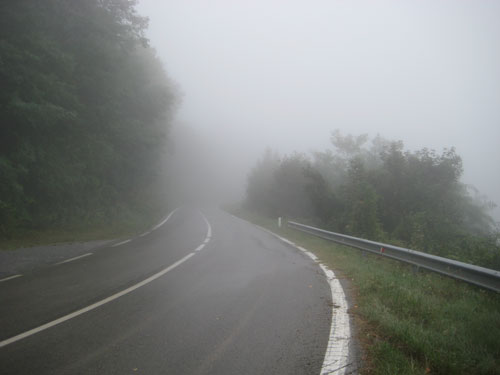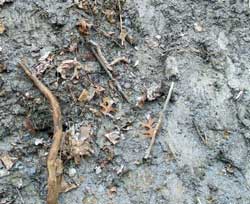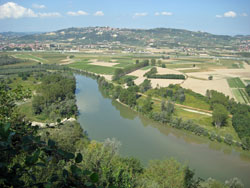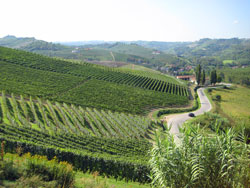
Barolo & Barbaresco: Where the Nebbia and Nebbiolo Hang
— — — — —
New: See Rascal’s Travels: Hail Cesare in Piemonte at: http://rascalspalate.com/?p=21
— — — — —
Heading east from Villefranche-Sur-Mer on the French Riviera, we left the comforting pleasure of the local Rosés to drive through the Italian seaside communes of San Remo and Albenga. We finally headed inland at Savona on the fast-paced A6 route. Our goal for the day was to reach Alba, the town at the heart of the Nebbiolo grape growing region pinned on its western and eastern flanks by Barolo and Barbaresco, respectively. The purpose of the visit was to learn about the unique starring role of the Nebbiolo grape in the wines that take their name from these two communes, and the roles played by the supporting cast of Barbera, Dolcetto, Muscato and lesser known local varietals such as Arneis.
As we gained elevation into the mountains of Linguria, the smell of moisture was in the air, a foreshadowing of an ever present element of the Piemonte (Piedmont) region of northwest Italy. By the time we exited the A6 at Millesimo, we entered a light mist overtaking us from the north. From this point our path took a different turn; in fact, many turns as we snaked along narrow high-country roads through a series of Piemonte hillside villages and towns.
In the Piemonte hills, little did we realize that our first “Lesson in Nebbiolo” was at hand. Most of the time spent driving along the high, narrow Piemonte roads, we were under a blanket of milk-white fog that seemed to ascend and descend as we drive up and down the hills. This fog is known locally as the nebbia. It plays an ever present role in the fate of the wines of this region and also shares its name with the areas dominant grape varietal, Nebbiolo. When the nebbia arrives, the temperatures moderate and ripening of the grapes slows, sometimes extending the growing season (a good thing), but at other times the fog brings ripening to a halt or can promote unwanted disease to the grapevines (a bad thing).
The Mystery of Nebbiolo
A lingering mystery of the Nebbiolo grape of the Piemonte region is why this grape has not produced wines of similar characteristics and intensity in other wine regions around the world. A grape grower on the Texas high plains mentioned something to me after learning of my upcoming trip to this region. He said, “Nebbiolo is still a mystery to me. I have tried to grow it, but its canes are very skinny and remind me of a tangle of wire. The leaves are small and the whole vine looks like a rootstock that had been trained into the trellis. The resultant wine is more like Rosé rather than having the dark tannic character normally associated with the wines of Barolo”.
 According to the local Baroliati, the reason for the success of Nebbiolo in Barolo and Barbaresco is a actually combination of unique aspects particular to the region around Alba. First is the special soil type prevalent in the two major wine producing areas of Barolo and Barbaresco. It is the heavy clay that is high in Calcium, Manganese and Magnesium that takes on a noticeable blue color as we traveled from east to west in the area. In fact, the Tanaro River that separates the regions of Barolo and Barbaresco from Roero to the north has a noticeable blue/green tinge caused by these clay materials in the water. Unlike most wine grapes that prefer loose, open, quick draining, often sandy soils, Nebbiolo appears to like its roots held tightly in the dense clay and especially
According to the local Baroliati, the reason for the success of Nebbiolo in Barolo and Barbaresco is a actually combination of unique aspects particular to the region around Alba. First is the special soil type prevalent in the two major wine producing areas of Barolo and Barbaresco. It is the heavy clay that is high in Calcium, Manganese and Magnesium that takes on a noticeable blue color as we traveled from east to west in the area. In fact, the Tanaro River that separates the regions of Barolo and Barbaresco from Roero to the north has a noticeable blue/green tinge caused by these clay materials in the water. Unlike most wine grapes that prefer loose, open, quick draining, often sandy soils, Nebbiolo appears to like its roots held tightly in the dense clay and especially  benefits from the special minerality of the local soil. The aspect of soil also accounts for the generally lower quality of the Nebbiolo wines in the northerly Roero region. There, the soils are predominantly sandy and noticeably lighter than in Barbaresco and especially when compared to those in Barolo where the Nebbiolo wines are darkest and most concentrated. In Roero, you are much more likely to experience red wines made from Barbera and Dolcetto and the white wines made with the native white Arneis grape. Farther to the east from Barbaresco toward the cities of Asti and Canelli the soils and climate favor the red wines made from Barbera and the often sweet and at times sparkling white wines made from the Muscato grape.
benefits from the special minerality of the local soil. The aspect of soil also accounts for the generally lower quality of the Nebbiolo wines in the northerly Roero region. There, the soils are predominantly sandy and noticeably lighter than in Barbaresco and especially when compared to those in Barolo where the Nebbiolo wines are darkest and most concentrated. In Roero, you are much more likely to experience red wines made from Barbera and Dolcetto and the white wines made with the native white Arneis grape. Farther to the east from Barbaresco toward the cities of Asti and Canelli the soils and climate favor the red wines made from Barbera and the often sweet and at times sparkling white wines made from the Muscato grape.
Another reason given by the locals for the success of Nebbiolo in the area around Alba is the special microclimate of the region. The southeast and southwest facing slopes favor a slow, extended period of ripening late in the growing season. Harvest of the late ripening Nebbiolo grapes can sometimes be delayed into October.
Traditionalist and Modernist Winemaking
 Another interesting aspect of the Nebbiolo-based wines of Barolo and Barbaresco is the give and take between traditional and modern production methods. Traditionalist winemakers have retained methods developed in the mid-1800s by the Frenchman, Louis Oudart, for the Italian King Vittorio Emmanual II. They consist of long maceration (sometimes months long) followed by long periods of aging in large oak casks called botti. The resulting wines are overpoweringly tannic yet often austere wines that require 10 to 20 years of bottle age before they reach their peak characteristics, if they reach it at all. Modernists in the region have gone to shorter maceration and newer rotary fermenter and other techniques that hold the grapes below the level of the fermenting must. These methods extract more fruit characteristics and color while reducing the pick-up of hard skin and seed tannins by the wine. These modern wines typically require a shorter aging time in oak and can be enjoyed after as little as 3 to 5 years in the bottle. The controversy between these two styles that was battled in the region since the 1980s has now settled down a bit with most major producers finding an acceptable middle ground between old and new methods to produce fresher and more approachable wines.
Another interesting aspect of the Nebbiolo-based wines of Barolo and Barbaresco is the give and take between traditional and modern production methods. Traditionalist winemakers have retained methods developed in the mid-1800s by the Frenchman, Louis Oudart, for the Italian King Vittorio Emmanual II. They consist of long maceration (sometimes months long) followed by long periods of aging in large oak casks called botti. The resulting wines are overpoweringly tannic yet often austere wines that require 10 to 20 years of bottle age before they reach their peak characteristics, if they reach it at all. Modernists in the region have gone to shorter maceration and newer rotary fermenter and other techniques that hold the grapes below the level of the fermenting must. These methods extract more fruit characteristics and color while reducing the pick-up of hard skin and seed tannins by the wine. These modern wines typically require a shorter aging time in oak and can be enjoyed after as little as 3 to 5 years in the bottle. The controversy between these two styles that was battled in the region since the 1980s has now settled down a bit with most major producers finding an acceptable middle ground between old and new methods to produce fresher and more approachable wines.
In the next installment, I will taste the local wines and enjoy the Cuisine d’Alba.


I live, vicariously, through your travels. Please, taste slowly and write generously.
Best,
Don